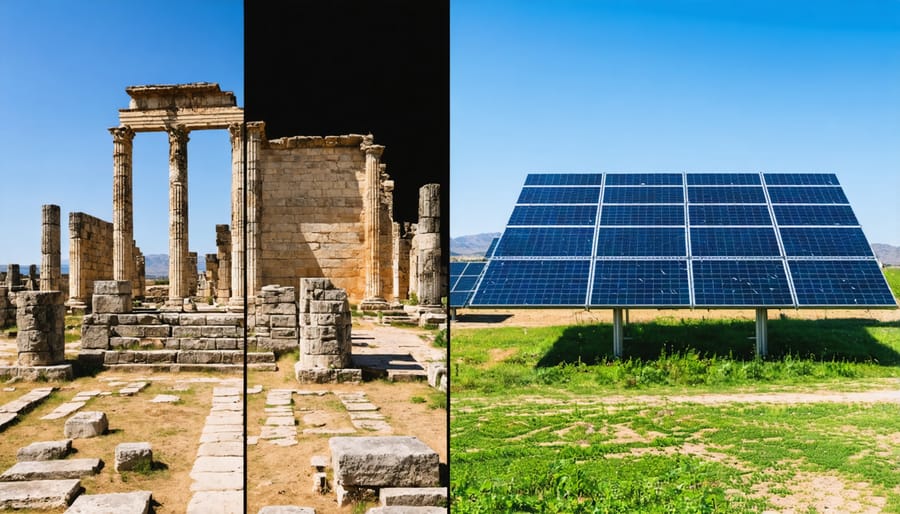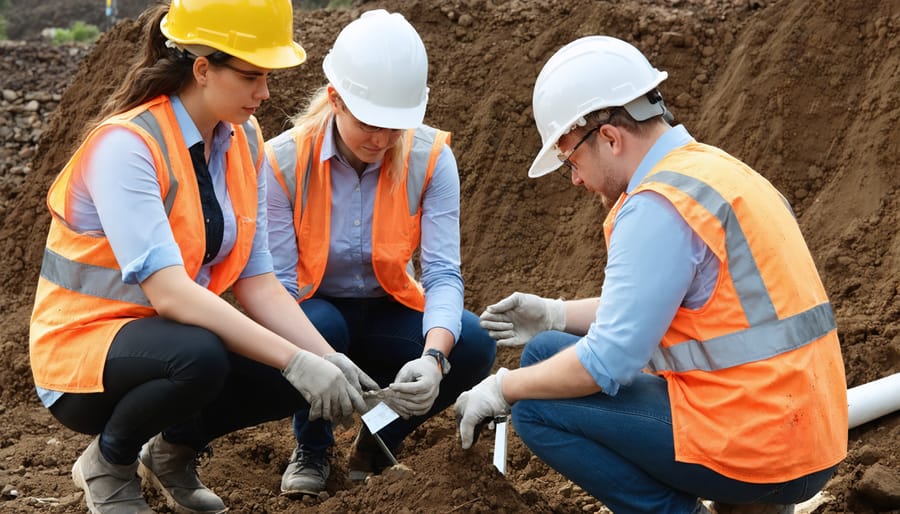Cultural heritage embodies the living essence of human civilization, representing far more than just artifacts and monuments. It encompasses the intangible threads of traditions, knowledge systems, and social practices that bind communities across generations. In today’s rapidly evolving global landscape, understanding and preserving cultural heritage has become increasingly critical for sustainable development and social cohesion.
For business leaders and project developers, cultural heritage consideration isn’t merely a regulatory requirement—it’s a strategic imperative that drives project success and community acceptance. When properly integrated into development initiatives, cultural heritage management creates lasting value by fostering positive stakeholder relationships, reducing project risks, and building sustainable, culturally-responsive solutions.
The intersection of modern development and cultural preservation presents both challenges and opportunities. Forward-thinking organizations recognize that respecting and incorporating cultural heritage elements into their projects isn’t just about compliance—it’s about creating meaningful connections with local communities while ensuring project longevity. This approach transforms potential obstacles into valuable assets that enhance project outcomes and strengthen corporate social responsibility initiatives.
Through systematic assessment, thoughtful integration, and proactive engagement with cultural heritage considerations, organizations can develop more resilient and socially sustainable projects that benefit both developers and communities alike.
Defining Cultural Heritage in Energy Projects
Tangible vs. Intangible Heritage
Cultural heritage manifests in two distinct forms: tangible and intangible elements. Tangible heritage encompasses physical artifacts such as historical buildings, archaeological sites, monuments, and artifacts that carry cultural significance. These concrete elements provide visible evidence of our past and require careful preservation during development projects.
In contrast, intangible heritage consists of living expressions passed down through generations, including indigenous cultural practices, oral traditions, performing arts, social customs, and traditional knowledge systems. While less visible than physical sites, these cultural elements are equally vital to community identity and social cohesion.
Project developers must consider both aspects when planning energy installations. While tangible heritage often requires physical protection and buffer zones, intangible heritage necessitates community engagement and cultural sensitivity in project design and implementation. Understanding this dual nature of cultural heritage enables more effective integration of preservation measures into sustainable development initiatives, ensuring both physical landmarks and living traditions continue to thrive alongside modern infrastructure.

Legal and Regulatory Framework
The protection of cultural heritage sites in energy development projects is governed by a complex framework of international conventions, national laws, and local regulations. Key international agreements include the UNESCO World Heritage Convention and the ICOMOS Guidelines, which establish fundamental principles for preserving cultural assets during development activities.
At the national level, most countries have specific legislation requiring cultural heritage impact assessments before project approval. In the United States, the National Historic Preservation Act (NHPA) Section 106 mandates consultation with relevant stakeholders and detailed archaeological surveys prior to any federal undertaking. Similar frameworks exist in the European Union under the Environmental Impact Assessment Directive.
Project developers must also comply with local heritage protection ordinances and indigenous peoples’ rights legislation. This often involves obtaining special permits, conducting thorough documentation, and implementing mitigation measures where necessary. Failure to comply with these requirements can result in significant project delays, financial penalties, and potential legal action.
Regular updates to these regulations reflect evolving best practices and increasing emphasis on protecting both tangible and intangible cultural heritage during energy infrastructure development.
Impact Assessment and Management
Cultural Heritage Impact Studies
Cultural heritage impact studies are systematic assessments that evaluate how proposed developments or changes might affect historical, cultural, and archaeological resources. These studies typically involve a multi-phase approach, beginning with preliminary desktop research and progressing to detailed field investigations conducted by qualified heritage professionals.
The assessment process includes documenting existing cultural assets, analyzing potential direct and indirect impacts, and proposing mitigation strategies. Key components include stakeholder consultation, particularly with indigenous communities and local cultural organizations, to ensure comprehensive understanding of the site’s significance.
These studies are crucial for several reasons. They help organizations comply with regulatory requirements, protect valuable cultural resources, and maintain positive relationships with local communities. They also provide essential data for project planning and risk management, potentially saving significant costs by identifying issues early in the development process.
A thorough heritage impact study typically examines:
– Physical impacts on heritage structures or sites
– Visual impacts on cultural landscapes
– Socio-cultural effects on community practices and traditions
– Cumulative impacts considering other developments in the area
The findings from these assessments inform project design modifications, construction methodologies, and operational procedures. Successful impact studies result in balanced solutions that preserve cultural heritage while enabling sustainable development, often leading to enhanced project outcomes through improved community acceptance and reduced implementation risks.
Stakeholder Engagement Strategies
Effective stakeholder engagement is crucial for successful cultural heritage preservation and integration with modern development projects. The process begins with identifying key stakeholders, including indigenous communities, local historical societies, cultural experts, and relevant government agencies. Early and continuous engagement helps ensure equitable energy development while respecting cultural values.
Successful engagement strategies typically include:
1. Regular community consultations through workshops and town halls
2. Formation of advisory committees with local cultural representatives
3. Documentation and incorporation of traditional knowledge
4. Transparent communication channels for ongoing feedback
5. Capacity building programs for local stakeholders
Project developers should establish clear protocols for engagement, including:
– Regular status updates and progress reports
– Formal mechanisms for addressing concerns
– Cultural sensitivity training for project teams
– Documentation of all engagement activities
– Integration of stakeholder input into project planning
It’s essential to maintain detailed records of all engagement activities and demonstrate how stakeholder feedback influences project decisions. This approach not only ensures compliance with regulatory requirements but also builds trust and creates sustainable partnerships with local communities. Successful stakeholder engagement often leads to better project outcomes and can serve as a model for future development initiatives.

Solar Energy Solutions and Heritage Preservation
Design Integration Techniques
Successful integration of solar installations in heritage settings requires a delicate balance between modern technology and historical preservation. The most effective approach involves using visually compatible materials that complement existing architectural elements while maintaining the site’s cultural significance.
Roof-integrated solar systems can be designed to match traditional roofing materials, such as slate or terra cotta tiles, through careful color matching and panel arrangement. Building-integrated photovoltaics (BIPV) offer seamless incorporation into historical facades, windows, and other architectural features without compromising their aesthetic integrity.
Ground-mounted installations can be strategically positioned behind existing structures or screened with period-appropriate landscaping to minimize visual impact. Reversible mounting systems ensure that future removal leaves no permanent damage to historical structures, adhering to conservation principles.
Solar installations can also be incorporated into auxiliary structures or modern additions, preserving the primary heritage building’s authenticity while achieving sustainability goals. This approach has proven successful in numerous UNESCO World Heritage sites, where carefully planned solar arrays power visitor centers and maintenance facilities.
Advanced solar technologies, including transparent and colored solar panels, provide additional options for heritage-sensitive installations. These innovations allow for power generation while maintaining the visual characteristics that define protected cultural sites.

Case Studies of Success
Several exemplary projects demonstrate how solar energy implementation can successfully coexist with cultural heritage preservation. The Mont-Saint-Michel Abbey in France showcases innovative solar panel placement that maintains the site’s historic silhouette while generating 15% of its energy needs. The installation’s careful design ensures minimal visual impact on the UNESCO World Heritage site.
In Kyoto, Japan, the Kennin-ji Temple project illustrates how traditional architecture can incorporate modern solar technology. Custom-designed panels that mirror the temple’s tile patterns generate power while preserving the building’s 800-year-old aesthetic integrity.
Community-led solar initiatives in Italy’s historic Tuscany region demonstrate how entire districts can adopt renewable energy while protecting architectural heritage. The Medieval town of San Gimignano implemented solar arrays outside the historic center, maintaining its iconic towers while achieving 40% renewable energy usage.
These success stories share common elements: early stakeholder engagement, innovative design solutions, and careful consideration of heritage values. They prove that with proper planning and sensitivity, solar energy adoption can enhance rather than diminish cultural heritage sites.
Best Practices for Heritage-Conscious Development
Implementing heritage-conscious development requires a balanced approach that respects cultural values while advancing modern energy solutions. Successful projects begin with early stakeholder engagement, particularly with indigenous communities and local cultural authorities. This collaborative approach ensures that cultural significance is properly understood and respected throughout the project lifecycle.
Key practices include conducting comprehensive cultural heritage impact assessments before project initiation. These assessments should document both tangible and intangible cultural assets, evaluate potential impacts, and outline specific mitigation strategies. Project teams should integrate findings into their design phase, adapting plans to minimize disruption to heritage sites and cultural practices.
Visual impact management plays a crucial role in heritage-sensitive development. Projects should utilize appropriate screening techniques, careful placement of infrastructure, and design elements that complement the existing cultural landscape. In areas of high heritage value, consider implementing reversible installation methods that allow for future restoration of sites to their original condition.
Documentation and monitoring protocols are essential components of heritage-conscious development. Establish clear procedures for chance finds during construction and maintain detailed records of all heritage-related decisions and actions. Regular monitoring helps ensure compliance with preservation guidelines and enables quick response to emerging concerns.
For energy infrastructure projects, particularly in historic districts or culturally significant areas, developers should prioritize sustainable urban development approaches that integrate seamlessly with existing architectural elements. This might include using traditional building materials, adopting historically appropriate color schemes, or incorporating cultural motifs into modern designs.
Success stories demonstrate the effectiveness of these practices. For instance, the Heritage Solar Project in Kyoto, Japan, successfully integrated solar panels into a UNESCO World Heritage site by using traditional roof tiles with embedded photovoltaic cells. This innovative approach maintained the site’s cultural integrity while advancing renewable energy goals.
Training and capacity building for project teams should emphasize cultural sensitivity and heritage protection protocols. Regular workshops and cultural awareness programs help ensure all stakeholders understand their roles in preserving heritage values while implementing modern energy solutions.
Cultural heritage preservation and sustainable development are not mutually exclusive goals but rather complementary aspects of responsible project planning. By implementing comprehensive assessment methodologies, engaging stakeholders early in the process, and following established best practices, organizations can successfully integrate cultural heritage protection into their development initiatives. The key lies in striking the right balance between progress and preservation, ensuring that new projects enhance rather than diminish the cultural value of heritage sites.
The successful case studies and implementation strategies discussed demonstrate that with proper planning and sensitivity to local cultural contexts, development projects can proceed while safeguarding important heritage assets. This balanced approach not only helps maintain community support but also creates long-term value by preserving irreplaceable cultural resources for future generations.
Moving forward, project developers and stakeholders must continue to prioritize cultural heritage considerations in their planning processes, leveraging advanced technologies and assessment tools while maintaining open dialogue with local communities. This commitment to responsible development ensures that progress serves both economic and cultural interests, creating a sustainable framework for future growth that honors and protects our shared heritage.

